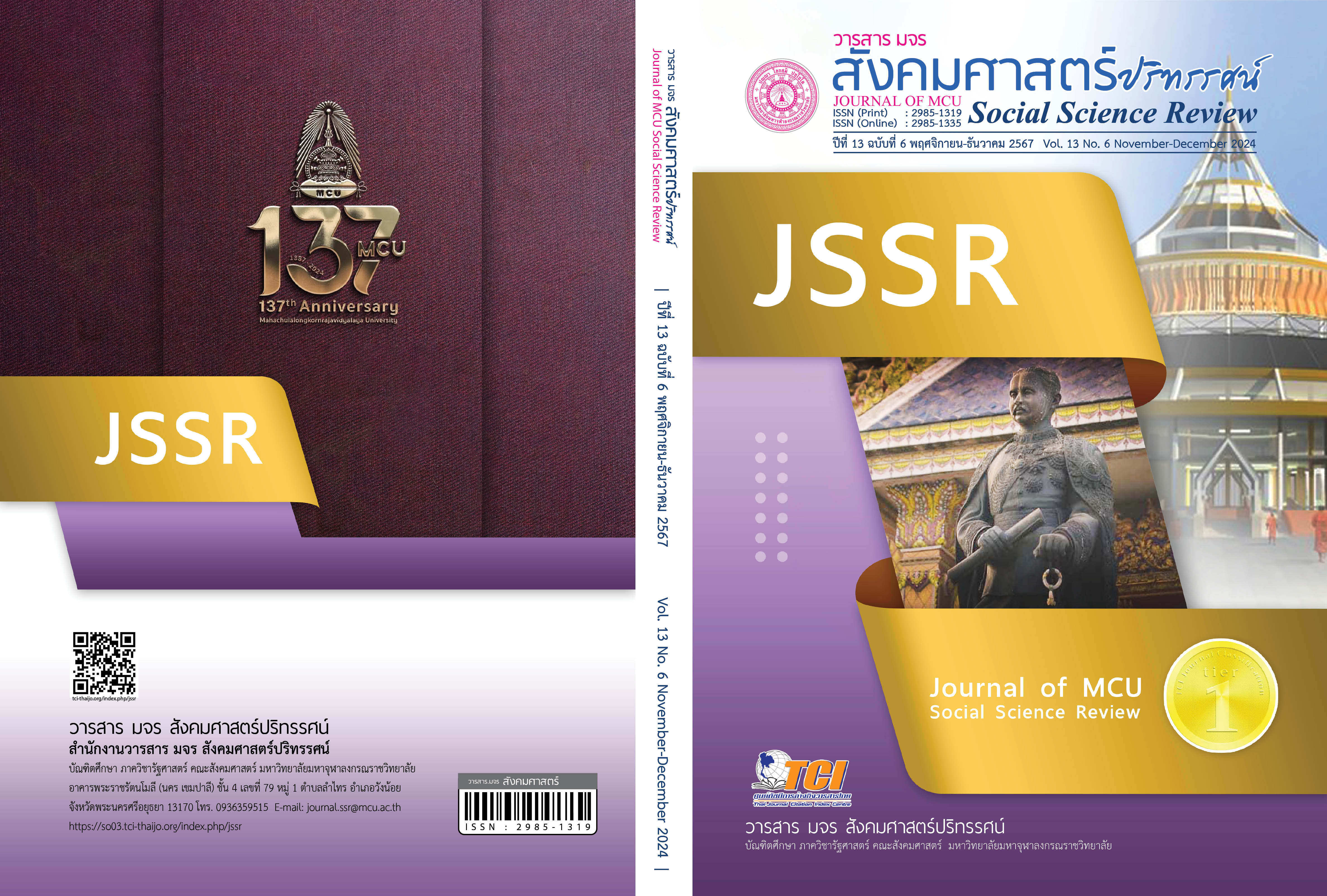มาตรการทางกฎหมายในการป้องกันการฟอกเงินผ่านนิติบุคคล
คำสำคัญ:
การฟอกเงิน, นิติบุคคล, มาตรการทางกฎหมาย, การป้องกันบทคัดย่อ
บทความวิจัยนี้มีวัตถุประสงค์ 1. ศึกษาแนวคิดทฤษฎีเกี่ยวกับการฟอกเงินผ่านนิติบุคคลของประเทศไทย ของต่างประเทศ แนวคำพิพากษาศาล และผลงานวิจัยที่เกี่ยวข้อง 2. ศึกษาปัญหาข้อเท็จจริงและข้อกฎหมายเกี่ยวกับการฟอกเงินผ่านนิติบุคคลของประเทศไทย 3. ศึกษาวิเคราะห์เปรียบเทียบมาตรการทางกฎหมายเกี่ยวกับการฟอกเงินผ่านนิติบุคคลของต่างประเทศกับของประเทศไทย และ 4. เสนอแนะมาตรการทางกฎหมายเกี่ยวกับการฟอกเงินผ่านนิติบุคคลของต่างประเทศที่มีความเหมาะสม มาปรับใช้กับกฎหมายไทยได้อย่างมีประสิทธิภาพ เป็นการวิจัยเชิงคุณภาพซึ่งเป็นการศึกษาวิจัยเอกสาร ตัวบทกฎหมาย ตำราทางวิชาการ งานวิจัย สื่ออิเล็กทรอนิกส์ของไทยและของต่างประเทศ มีการจัดทำสนทนากลุ่ม ประกอบการสัมภาษณ์เชิงลึกกลุ่มตัวอย่างทั้งหมด 5 สายงาน คือ นิติกรชำนาญการสำนักงานป้องกันและปราบปรามการฟอกเงิน ผู้อำนวยการกองคดียาเสพติด (DSI) ผู้อำนวยการส่วนกลั่นกรองและประสานการตรวจสอบ (ป.ป.ง) กลุ่มสำนักงานตำรวจแห่งชาติและผู้จัดการฝ่ายกฎหมาย บริษัท จำกัด (มหาชน)
ผลการวิจัยพบว่า 1. การฟอกเงินผ่านนิติบุคคล คือ การควบคุมการจัดตั้งนิติบุคคลที่สะดวกรวดเร็วและไม่รัดกุมในเรื่องของการตรวจสอบผู้รับประโยชน์ที่แท้จริง การออกใบหุ้นชนิดไม่ระบุชื่อที่ขัดกับข้อแนะนำของ FATF 2. นิติบุคคลที่มีลักษณะการถือหุ้นแทนคนต่างด้าว ไม่เป็นความผิดมูลฐานฟอกเงินจึงไม่สามารถดำเนินคดีฐานฟอกเงินได้ 3. ประเทศที่ผู้วิจัยนำมาศึกษาคือ ประเทศสหรัฐอเมริกาประเทศแคนาดา เครือรัฐออสเตรเลีย เขตปกครองพิเศษฮ่องกงสมาพันธรัฐสวิสและกฎหมายของกฎหมายของราชอาณาจักรไทยได้กำหนดความผิดเกี่ยวกับการฟอกเงินเป็นความผิดทางอาญาแล้วทั้งสิ้น 4. การฟอกเงินเป็นความผิดทางอาญาและต้องกำหนดให้ความผิดร้ายแรงทุกประเภทเป็นความผิดฐานฟอกเงิน โดยมีเจตนาเพื่อกำหนดความผิดมูลฐานให้ครอบคลุมขอบเขตกว้างขวางที่สุด
เอกสารอ้างอิง
ขจีรัตน์ อัครจิตสกุล. (2551). กฎหมายป้องกันและปราบปรามการฟอกเงิน ศึกษากรณีการรายงานธุรกรรมขององค์กรที่มีความเสี่ยงต่อการกระทำความผิดฐานฟอกเงิน (วิทยานิพนธ์นิติศาสตรมหาบัณฑิต สาขาวิชานิติศาสตร์). กรุงเทพฯ: จุฬาลงกรณ์มหาวิทยาลัย.
ชัยนันท์ แสงปุตตะ. (2541). กฎหมายว่าด้วยการป้องกันและปราบปรามการฟอกเงิน : ศึกษาเฉพาะกรณีความผิดมูลฐาน (วิทยานิพนธ์นิติศาสตรมหาบัณฑิต สาขาวิชานิติศาสตร์). กรุงเทพฯ: จุฬาลงกรณ์มหาวิทยาลัย.
ไพฑูรย์ ประเสริฐไกล. (2561). การศึกษาการฟอกเงินกับตัวแปรทางเศรษฐกิจระดับมหภาค. กรุงเทพฯ: มหาวิทยาลัยศรีนครินทร์วิโรฒ.
วีระชาติ ศรีบุญมา. (2555). การดำเนินคดีทุจริตสถาบันการเงินและการติดตามทรัพย์สินคืนในภาวะวิกฤตสถาบันการเงินไทยปี 2540 (วิกฤตต้มยำกุ้ง). กรุงเทพฯ: กระทรวงต่างประเทศ.
ศิรสา ไชยหมาน และคณะ. (2565). สภาพปัญหาการกำหนดความผิดมูลฐานตามกฎหมายว่าด้วยการป้องกันและปราบปรามการฟอกเงิน. กรุงเทพฯ: กองกฎหมายกระบวนการยุติธรรม.
สถาบันวิจัยเพื่อการพัฒนาประเทศไทย (ทีดีอาร์ไอ). (2564). รายงานวิจัยฉบับสมบูรณ์ เรื่องแนวโน้มการฟอกเงินในประเทศไทย : ศึกษาเฉพาะกรณีการฟอกเงินผ่านนิติบุคคลและธุรกิจบังหน้า ทนายความและนักบัญชี บริษัทนําเที่ยว ทรัสต์ต่างประเทศที่ดำเนินการในประเทศไทยการเล่นแชร์ที่มีการฉ้อโกงและการฟอกเงินผ่านองค์กรไม่แสวงหากําไร. สืบค้น 7 มีนาคม 2565, จาก https://shorturl.asia/8McXN
สำนักงานป้องกันและปราบปรามการฟอกเงิน (ปปง.). (2563). ระเบียบวิธีเพื่อการประเมินการปฏิบัติตามข้อแนะนำของ FATF และการประเมินประสิทธิผลของระบบ AML/CFT. กรุงเทพฯ: สำนักงานป้องกันและปราบปรามการฟอกเงิน.
สุรพล ไตรเวทย์. (2542). คำอธิบายกฎหมายฟอกเงิน (พิมพ์ครั้งที่ 2). กรุงเทพฯ: วิญญูชน.
ดาวน์โหลด
เผยแพร่แล้ว
รูปแบบการอ้างอิง
ฉบับ
ประเภทบทความ
สัญญาอนุญาต
ลิขสิทธิ์ (c) 2024 วารสาร มจร สังคมศาสตร์ปริทรรศน์

อนุญาตภายใต้เงื่อนไข Creative Commons Attribution-NonCommercial-NoDerivatives 4.0 International License.
เพื่อให้เป็นไปตามกฎหมายลิขสิทธิ์ ผู้นิพนธ์ทุกท่านต้องลงลายมือชื่อในแบบฟอร์มใบมอบลิขสิทธิ์บทความให้แก่วารสารฯ พร้อมกับบทความต้นฉบับที่ได้แก้ไขครั้งสุดท้าย นอกจากนี้ ผู้นิพนธ์ทุกท่านต้องยืนยันว่าบทความต้นฉบับที่ส่งมาตีพิมพ์นั้น ได้ส่งมาตีพิมพ์เฉพาะในวารสาร มจร สังคมศาสตร์ปริทรรศน์ เพียงแห่งเดียวเท่านั้น หากมีการใช้ภาพหรือตารางหรือเนื้อหาอื่นๆ ของผู้นิพนธ์อื่นที่ปรากฏในสิ่งตีพิมพ์อื่นมาแล้ว ผู้นิพนธ์ต้องขออนุญาตเจ้าของลิขสิทธิ์ก่อน พร้อมทั้งแสดงหนังสือที่ได้รับการยินยอมต่อบรรณาธิการ ก่อนที่บทความจะได้รับการตีพิมพ์ หากไม่เป็นไปตามข้อกำหนดเบื้องต้น ทางวารสารจะถอดบทความของท่านออกโดยไม่มีข้อยกเว้นใดๆ ทั้งสิ้น





